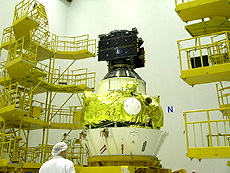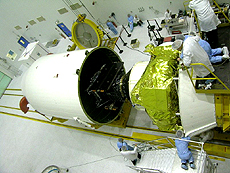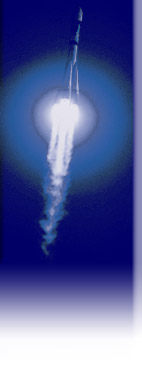The GIOVE-A satellite for Starsem's upcoming mission completes its integration
December 21, 2005
 |
The completed payload "stack" is shown in
Starsem's clean room. The cube-shaped
GIOVE-A satellite is mounted on its adapter
and mated to the Fregat upper stage (which is
covered by gold-colored insulation blankets). |
|
Starsem's final mission for 2005 has passed a key milestone with the integration of its GIOVE-A navigation satellite into the Soyuz launcher's payload fairing.
Working in Starsem's state-of-the-art clean room facilities at the Baikonur Cosmodrome, launch team members first mated the GIOVE-A to its cone-shaped payload adapter.
The spacecraft and adapter were then installed on the Fregat re-ignitable upper stage, which is to inject GIOVE-A into orbit following its separation from the Soyuz launch vehicle.
This payload "stack" was then horizontally integrated into the Soyuz payload fairing, completing the encapsulation process for GIOVE-A - the initial satellite in Europe's new Galileo space-based navigation system.
Mission planning calls for the payload to be transferred tonight to the launcher integration building (known as MIK 40), where it will be mated to the Russian-build Soyuz launch vehicle.
The completed Soyuz will be transferred horizontally by rail line to Baikonur Cosmodrome's Launch Pad no. 6 on December 25, where the vehicle will be raised to its vertical position for final preparations.
Liftoff of the Soyuz is set for December 28 at 11:19 a.m. (local Kazakhstan time).
 |
This excellent overhead image details the
encapsulation process for GIOVE-A, as the
satellite and its Fregat upper stage are joined
using a horizontal integration process. |
|
The mission originally had been planned for December 26, but was delayed after the detection of an anomaly in the ground station network that will track and control the GIOVE-A satellite.
GIOVE-A is the first of two spacecraft developed to validate the Galileo satellite-based navigation system's technologies, which have been developed under European Space Agency contracts.
The satellite was produced by Surrey Space Technology Ltd. of the United Kingdom, and has a launch mass of 600 kg. A cube-shaped platform sized at 1.3 x 1.8 x 1.65 meters, the GIOVE-A spacecraft and is powered by a butane propulsion system.
Its sister satellite, GIOVE-B, is slated for launch on another Starsem Soyuz vehicle in 2006.
Once fully deployed, Europe's Galileo navigation system will consist of 30 satellites: 27 operational, plus three active spares.
This constellation will positioned in three circular Medium Earth Orbit (MEO) planes at 23,222 km. above the Earth, with each orbital plane inclined at 56 degrees to the equatorial plane.
The upcoming GIOVE-A mission will be the 15th Soyuz commercial flight performed under Starsem's responsibility.
For additional information on the successful Starsem GIOVE-A launch, review the previous updates, along with the post-mission press release and Starsem's official launch kit.
Press release:
- Read our press release about this successful Starsem mission.
Launch kit:
- Download the Starsem Starsem GIOVE-A launch kit for additional information on the mission and the Soyuz launch system. (2,344 Kb)







